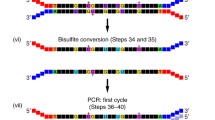Abstract
Post-bisulfite adaptor tagging (PBAT) is a concept that enables the preparation of an efficient sequencing library from bisulfite-treated DNA, and it also means the protocol implemented the concept. Although the previous PBAT or rPBAT was sensitive enough for single-cell methylome analysis, the protocol had several drawbacks owing to the repeated random priming reactions. To resolve these problems, we developed a unique single-strand DNA ligation technique, termed TACS ligation, and established a new protocol called tPBAT. With tPBAT, the data quality improved, with a longer insert and higher map** rate than that obtained with rPBAT. In addition, paired-end sequencing and indexing were supported by the default. In this chapter, the tPBAT protocol is introduced, and a thorough description of its application to small samples is provided.
Access this chapter
Tax calculation will be finalised at checkout
Purchases are for personal use only
Similar content being viewed by others
References
Cokus SJ, Feng S, Zhang X et al (2008) Shotgun bisulphite sequencing of the Arabidopsis genome reveals DNA methylation patterning. Nature 452(7184):215–219. https://doi.org/10.1038/nature06745
Lister R, O’Malley RC, Tonti-Filippini J et al (2008) Highly integrated single-base resolution maps of the epigenome in Arabidopsis. Cell 133(3):523–536. https://doi.org/10.1016/j.cell.2008.03.029
Adey A, Shendure J (2012) Ultra-low-input, tagmentation-based whole-genome bisulfite sequencing. Genome Res 22(6):1139–1143. https://doi.org/10.1101/gr.136242.111
Miura F, Enomoto Y, Dairiki R et al (2012) Amplification-free whole-genome bisulfite sequencing by post-bisulfite adaptor tagging. Nucleic Acids Res 40(17):e136. https://doi.org/10.1093/nar/gks454
Raine A, Manlig E, Wahlberg P et al (2017) SPlinted Ligation Adapter Tagging (SPLAT), a novel library preparation method for whole genome bisulphite sequencing. Nucleic Acids Res 45(6):e36–e36. https://doi.org/10.1093/nar/gkw1110
Hui T, Cao Q, Wegrzyn-Woltosz J et al (2018) High-resolution single-cell DNA methylation measurements reveal epigenetically distinct hematopoietic stem cell subpopulations. Stem Cell Rep 11(2):578–592. https://doi.org/10.1016/j.stemcr.2018.07.003
Sun Z, Vaisvila R, Yan B et al (2019) Non-destructive enzymatic deamination enables single molecule long read sequencing for the determination of 5-methylcytosine and 5-hydroxymethylcytosine at single base resolution. Genome Res. https://doi.org/10.1101/2019.12.20.885061
Vaisvila R, Ponnaluri VKC, Sun Z et al (2021) Enzymatic methyl sequencing detects DNA methylation at single-base resolution from picograms of DNA. Genome Res. https://doi.org/10.1101/gr.266551.120
Simpson JT, Workman RE, Zuzarte PC et al (2017) Detecting DNA cytosine methylation using nanopore sequencing. Nat Methods 14(4):407–410. https://doi.org/10.1038/nmeth.4184
Wallace EV, Stoddart D, Heron AJ et al (2010) Identification of epigenetic DNA modifications with a protein nanopore. Chem Commun (Camb) 46(43):8195–8197. https://doi.org/10.1039/c0cc02864a
Smallwood SA, Lee HJ, Angermueller C et al (2014) Single-cell genome-wide bisulfite sequencing for assessing epigenetic heterogeneity. Nat Methods 11(8):817–820. https://doi.org/10.1038/nmeth.3035
Miura F, Shibata Y, Miura M et al (2019) Highly efficient single-stranded DNA ligation technique improves low-input whole-genome bisulfite sequencing by post-bisulfite adaptor tagging. Nucleic Acids Res 47(15):e85. https://doi.org/10.1093/nar/gkz435
Shirane K, Miura F, Ito T et al (2020) NSD1-deposited H3K36me2 directs de novo methylation in the mouse male germline and counteracts Polycomb-associated silencing. Nat Genet 52(10):1088–1098. https://doi.org/10.1038/s41588-020-0689-z
Hamazaki N, Kyogoku H, Araki H et al (2021) Reconstitution of the oocyte transcriptional network with transcription factors. Nature 589(7841):264–269. https://doi.org/10.1038/s41586-020-3027-9
Toh H, Shirane K, Miura F et al (2017) Software updates in the Illumina HiSeq platform affect whole-genome bisulfite sequencing. BMC Genomics 18(1):31. https://doi.org/10.1186/s12864-016-3392-9
Suzuki M, Liao W, Wos F et al (2018) Whole-genome bisulfite sequencing with improved accuracy and cost. Genome Res 28(9):1364–1371. https://doi.org/10.1101/gr.232587.117
Acknowledgments
This work was supported by JSPS KAKENHI through grants to F.M. (20H03243) and T.I. (17H06305) and AMED Platform Project for Supporting Drug Discovery and Life Science Research (Basis for Supporting Innovative Drug Discovery and Life Science Research (BINDS)) through a grant to T.I. (Grant Number JP20am0101103).
Author information
Authors and Affiliations
Corresponding author
Editor information
Editors and Affiliations
Rights and permissions
Copyright information
© 2023 The Author(s), under exclusive license to Springer Science+Business Media, LLC, part of Springer Nature
About this protocol
Cite this protocol
Miura, F., Shibata, Y., Miura, M., Ito, T. (2023). Post-bisulfite Adaptor Tagging Based on an ssDNA Ligation Technique (tPBAT). In: Hatada, I., Horii, T. (eds) Epigenomics. Methods in Molecular Biology, vol 2577. Humana, New York, NY. https://doi.org/10.1007/978-1-0716-2724-2_2
Download citation
DOI: https://doi.org/10.1007/978-1-0716-2724-2_2
Published:
Publisher Name: Humana, New York, NY
Print ISBN: 978-1-0716-2723-5
Online ISBN: 978-1-0716-2724-2
eBook Packages: Springer Protocols




